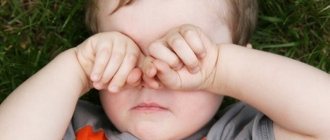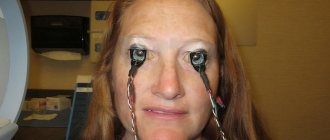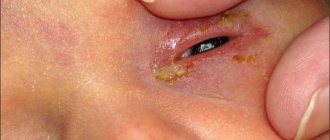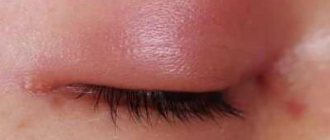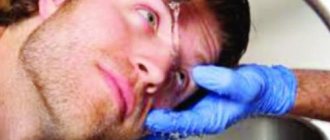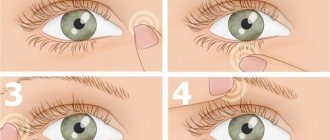From the moment a baby is born, a restless time begins for his parents; they are forced to keep an eye on the baby, controlling his behavior, because at an early age, it is changes in him that serve as the main method for detecting the development of various kinds of pathologies in the child’s body. When his usual actions and habits are complemented by the fact that the child rubs his eyes, loved ones begin to worry and suspect that he has health problems. But not everything always corresponds to assumptions.
This behavioral reaction can be caused by various reasons, and not all of them are a cause for serious concern. It is important for less experienced parents to know why their child rubs his eyes in order to be ready to provide him with appropriate help and understand in which cases it is better to contact a specialist.
Why does this pathology occur?
In some cases, you can determine the causes of itching and redness around the eyes or on the cornea itself. Sometimes it is enough to just rinse the affected areas a few times to eliminate discomfort. However, you should not completely rely on this, since visually identical symptoms can indicate both the entry of specks into the eyes and the development of pathological changes. If a child's eyes are swollen and itchy, it is important to correctly determine the cause of this condition.
Allergic conjunctivitis
It is expressed when a certain allergen comes into contact with the mucous membrane of the eyes. At the same time, an allergic reaction is an individual phenomenon. It is not contagious, unlike bacterial and viral conjunctivitis. For allergy sufferers, when an irritant enters the respiratory tract or mucous membranes, as well as the skin, the body regards them as foreign, although in fact they are not; other people tolerate them absolutely calmly. For example, when poplars bloom, many feel normal, and only some begin to experience eye irritation and accompanying symptoms. Why is this happening?
When bacteria or viruses enter the human body, they are perceived as foreign, and the immune system activates protective reactions. Blood T cells signal the production of antibodies aimed at destroying pathogens. In a person suffering from allergies, the immune system malfunctions; it begins to recognize the “enemy” not only in dangerous viruses, but also in completely harmless substances: food products, cosmetics, pollen, etc.
An allergy can occur at any time, even to the fur of a beloved animal that has lived with the owner for many years. Babies may have a negative reaction to the protein found in breast milk. No one can predict why or when such a failure will occur. It also happens that allergies go away on their own, for example, in adolescents after puberty.
Lack of sleep, overexertion
A child's eyes swell and itch often for these reasons. In this case, you should reconsider your baby’s daily routine. First of all, it is necessary to reduce the time spent watching TV and using gadgets, embroidering, knitting, playing and working on the computer. When the symptoms disappear, such harsh measures can be somewhat relaxed. It is also important to ensure that your child gets enough sleep. The average sleep duration for children of primary school age should be 10 hours.
Why do children still have red, swollen eyes? They also itch very often.
Itchy eyes of a child: reasons
You can determine the factors that caused redness and itching around the eyes or the corneas themselves. In some cases, it is enough to rinse the affected area once or twice, and the discomfort will go away. You cannot rely on this, because the same visual symptoms may indicate that a speck has entered and a developing pathology. If a child constantly scratches his eyes, it is very important to correctly determine the cause of the itching.
Entry of a foreign object
Midges, specks, and grains of sand fly into your eyes. If children “help with the housework,” it could well be shavings or construction mixture. The entry of a foreign body, which is not always visible due to its microscopic size, causes an immediate burning sensation. The baby tries to scratch the itchy eye, the pain becomes stronger, tears flow.
Overexertion and lack of sleep
A common cause is redness and swelling around the eyes. It is necessary to reconsider the child’s daily routine. First, exclude watching TV, games and computer activities, knitting, embroidery. When the symptoms pass, such harsh measures are not necessary, and you can devote up to half an hour a day to exercise. It is also necessary to ensure adequate sleep time. Children of primary school age should sleep 10 hours.
Conjunctivitis
This is a common infection that requires mandatory treatment. Ignoring the necessary measures can lead to vision problems.
With conjunctivitis, the baby constantly scratches his eyes, the itching is accompanied by swelling, redness, and the appearance of pus in the corners.
Allergy
Children, especially under the age of 7, are sensitive to the environment: emissions into the atmosphere, animal hair, pollen, odors, and the material from which toys are made. The body reacts with redness and itching of the eyes, a runny or stuffy nose, and watery eyes.
Obstruction of the lacrimal canaliculus
A congenital pathology in which the conjunctiva is not lubricated by tear fluid. The baby's eyes are constantly itching and redness is noticeable. The problem may disappear on its own by the time the baby is one month old or require medical intervention.
Blepharitis
This is an inflammatory process on the eyelids, which occurs against the background of thinning of the epidermis and the absence of subcutaneous fatty tissue.
Main causes of the disease:
- decreased immunity;
- damage by worms or demodectic mites;
- hypothermia;
- avitaminosis;
- diseases of the endocrine system and digestive tract;
- dirt getting under the eyelids;
- staphylococcal infection.
Symptoms of the disease include dry eyes, thickening of the eyelids, redness and flaking of the skin, and crusting. The child’s eyes itch, the epidermis on the scalp becomes dry and peels off.
Wound healing
For the smallest wounds on the eyelids or cornea of the eye, the body produces healing components. At the same time, the child’s eye itches and redness appears from friction. You can eliminate discomfort by performing procedures at home.
Barley
Inflammation of the sebaceous gland appears with decreased immunity, chronic diseases of the respiratory tract, endocrine system, and after a strong cold wind.
There are two types of barley:
- External. An abscess occurs near the eyelash bulbs. The cause is inflammation of the sebaceous gland or hair follicle.
- Interior. It occurs as a result of inflammation of the meibomian gland and is located on the inside of the eyelid.
At first, the eye just itches a lot, then redness appears, and a small bump is noticeable. Its possible location can be seen in the photo.
The disease is not dangerous and goes away on its own within a week. In rare cases, headache and eyelid twitching are observed.
Blepharitis
It is a process of inflammation of the eyelids, occurring against the background of a lack of fatty tissue under the skin and thinning of the epidermis. The main reasons for the development of blepharitis are the following: infection with staphylococci, dirt getting under the eyelids, pathologies of the gastrointestinal tract, endocrine system, vitamin deficiency, hypothermia, damage by demodex, worms, decreased immunity. The main symptoms of blepharitis are as follows: dry eyes are observed, the eyelids thicken, the skin on them turns red and peels, and the formation of crusts is possible. In addition, the skin on the scalp may dry out and flake off.
Barley
It is an inflammatory process in the sebaceous gland, develops against the background of reduced immunity, after hypothermia in the wind, chronic pathologies of the endocrine system, and respiratory tract.
Barley can be internal or external. Localization of external styes is near the ciliary bulbs. The main reason for its appearance is inflammation of the hair follicle or sebaceous gland. Internal stye occurs due to inflammation of the meibomian gland. Its location is the inner side of the eyelid.
At the initial stage of development of stye, the eye begins to itch very much, after which redness develops and a small tubercle appears. This disease is not dangerous and usually goes away on its own. In some cases, stye can provoke eyelid twitching and headache.
If a child's eyes are swollen and itchy, treatment should be comprehensive.
Alarm Signals
Parents should be alarmed by the situation when the baby’s obsessive desire to rub their eyes occurs against the background of other manifestations, and especially if it does not stop even at night. It is advisable to show your baby to a professional if:
- his eyelids swell;
- redness of the eyes is observed;
- Tears are constantly flowing;
- discharge appears from the lacrimal glands;
- the eyelids “stick” immediately after waking up.
Such symptoms may indicate the presence of various types of diseases, infections, inflammation and allergies. A doctor can determine why a newborn and an older child are scratching their eyes and eliminate the possibility of allergic manifestations after conducting a full examination.
- Mom, take note, if your child is groaning and straining, he may have accumulated gas in his intestines, he wants to go to the toilet, and even he expresses a desire to communicate, read the article and you will understand everything.
- It is important to observe the norms for sugar in the child’s urine; you will need our advice and a table of norms, everything is here.
- Does the child have a temperature of 40 degrees without other symptoms? Very seriously, urgently call an ambulance and read our article to understand why this could happen.
Treatment for itchy eyes and swelling
If a child's eyes become swollen and itchy, and this condition persists for more than a day, you should visit a doctor who will determine the cause of the ailment and prescribe appropriate therapy. If the problem is minor, you can try to deal with it yourself.
Foreign body getting into the eye. It is strictly forbidden to try to remove the speck with your hands. First of all, Albucid (10%) should be instilled into the eyes. If the foreign body does not come out of the eye along with the drops, you must use a napkin or handkerchief. After removing the speck, the eyes must be treated with Tetracycline eye ointment.
Conjunctivitis. Treatment for conjunctivitis depends on the type of disease and the degree of its development. A specialist may recommend the use of one or several medications at once:
- "Vitabact". It is recommended to use three times a day. At night, you should treat your eyes with erythromycin, tetracycline, and oxolinic ointment.
- “Ophthalmoferon” It is recommended to instill 1 drop into the eyes up to 8 times a day until severe symptoms disappear. After this, the frequency of applications can be reduced to 3.
- "Okoferon". It is recommended to instill into the eyes every 2 hours on the first day, and then four times a day for a week.
- "Colbiocin". Can be used for no more than 5 days and only in children over 8 years of age. The drug should be instilled three times a day, 2 drops.
- "Tsipromed". Use up to 8 times a day, 1-2 drops. The duration of therapy can be up to 2 weeks.
- "Levomycetin". Three times a day, 1 drop. The maximum duration of therapy is one week.
- "Vitabact". Recommended up to 6 times a day for 10 days.
- "Eubetal." Can be used five times a day for a month.
- "Albucid". For a month, up to 6 times a day.
It is strictly forbidden to independently select drops for the treatment of conjunctivitis in children. The child’s body may have individual characteristics in which the components of the drugs can cause a burning sensation and the development of complications. In addition, some drugs cannot be combined with each other.
Allergy. For allergic reactions in children over 4 years old, the use of drugs such as “Octilia” (twice a day, 1 drop, no more than 4 days), “Lecrolin” (four times a day, 1 drop) is recommended. In addition, a specialist may recommend the use of Ketotifen for three months, 1 tablet twice a day. For the treatment of allergic reactions in children under one year of age, the use of syrup forms of drugs is indicated. If a bacterial or viral lesion occurs secondary, the specialist supplements the therapy or completely changes it.
Blockage of tear ducts. To moisturize children's eyes, you can use Vitabact, but only probing the canal will completely eliminate the problem.
Blepharitis. If a child's lower eyelids swell, itching develops, and redness occurs, one of the following medications should be used: Vitabact, Eubetal, Albucid. After this, you should consult an ophthalmologist. Therapy for blepharitis involves the use of antiseborrheic shampoos, physiotherapy, taking vitamins and antibiotics.
Barley. For the treatment of barley in infants, it is recommended to instill 1 drop of Tobrex or Albucid three times a day. From the age of one year, Ciprofloxan can be used every 4 hours, 2 drops. From the age of three it is possible to use Sofradex. The drops will be effective even if the barley is in an advanced stage. It is recommended to carry out instillations six times a day, 1–2 drops. Also effective are ointments such as “Tetracycline” and “Hydrocortisone”. They should be placed in the eye three times a day.
When a child's eyes are swollen and itchy, all parents should know what to do.
Types of allergic conjunctivitis
The reaction can occur to different substances. Here are the most common factors that cause inflammation of the mucous membranes:
- Hay fever, or spring rhinoconjunctivitis, is an allergy to pollen from flowering plants. Occurs in the spring and summer season. Usually the reaction occurs to pollen from cereals, weeds and some trees (poplar, birch, alder).
- Reaction to secretions of various glands of domestic animals. Many people believe that allergies occur due to fluff or wool, but this is not true. Irritation can occur even when in contact with hairless cats - Sphynx cats.
- Food allergies. The most common type. Occurs on cereals, nuts, proteins and other products or their components. Symptoms in this case may be aggravated by a skin rash, upset bowel movements, and difficulty breathing as the throat swells.
- Reaction to certain medications.
- Insect allergy to insect bites, etc.
Any type of allergy manifests itself in children with irritation and inflammation of the eyes, since their mucous membrane suffers first. If the above symptoms appear, parents should promptly contact an ophthalmologist to determine the cause of the allergy and obtain a prescription for medications.
For the treatment of allergic inflammation of the eyes, children are prescribed drops that eliminate eyelid swelling and redness, for example, Vizin, antihistamines Allergodil, Alezastin, Olopatadine. All prescribed medications must be used strictly in accordance with the doctor’s instructions.
